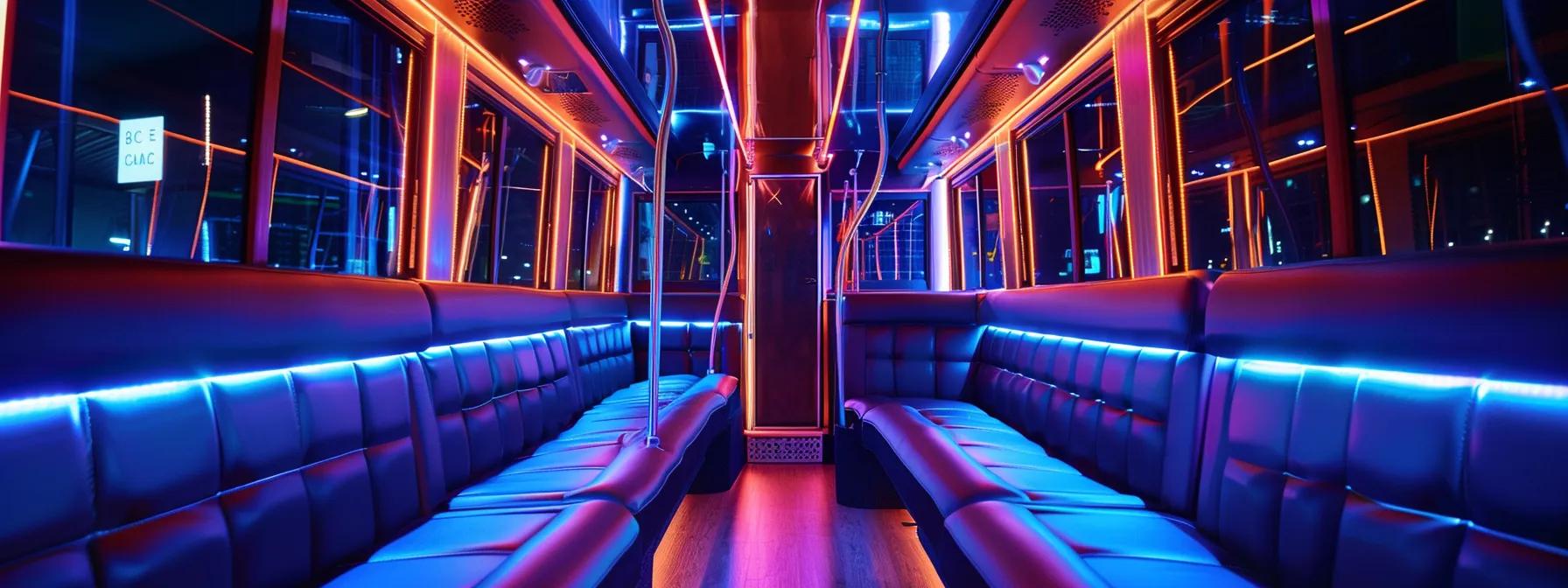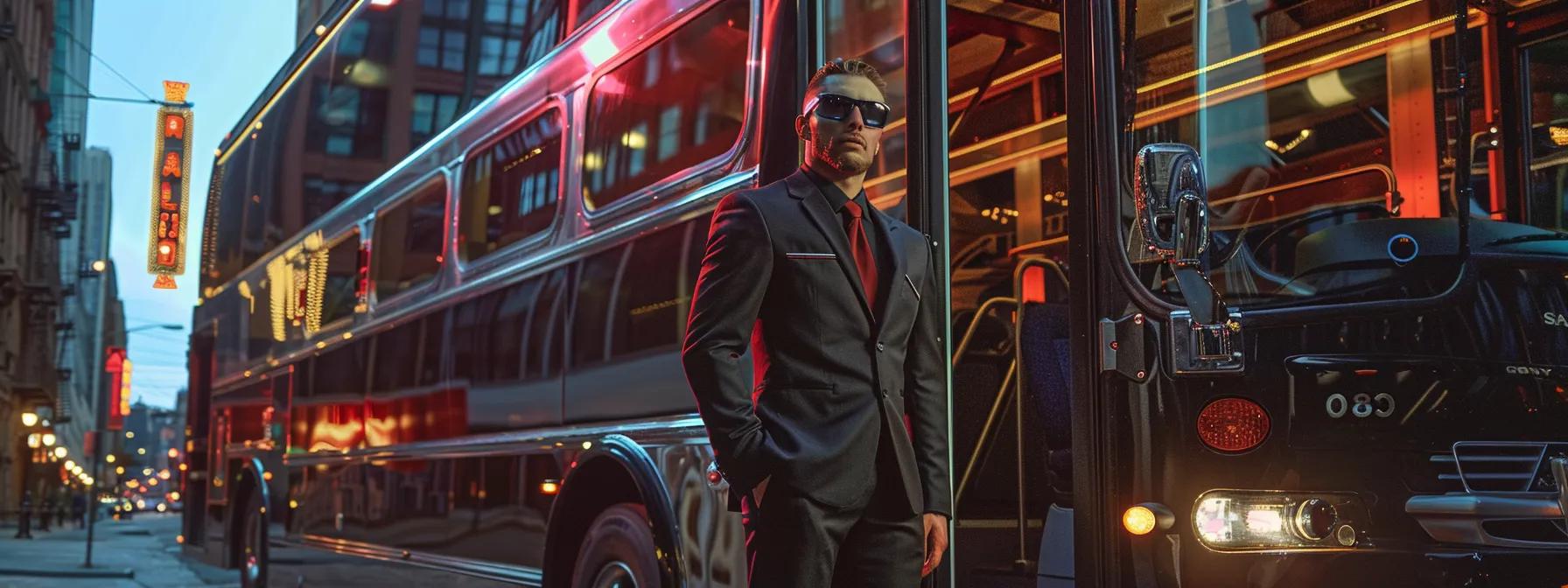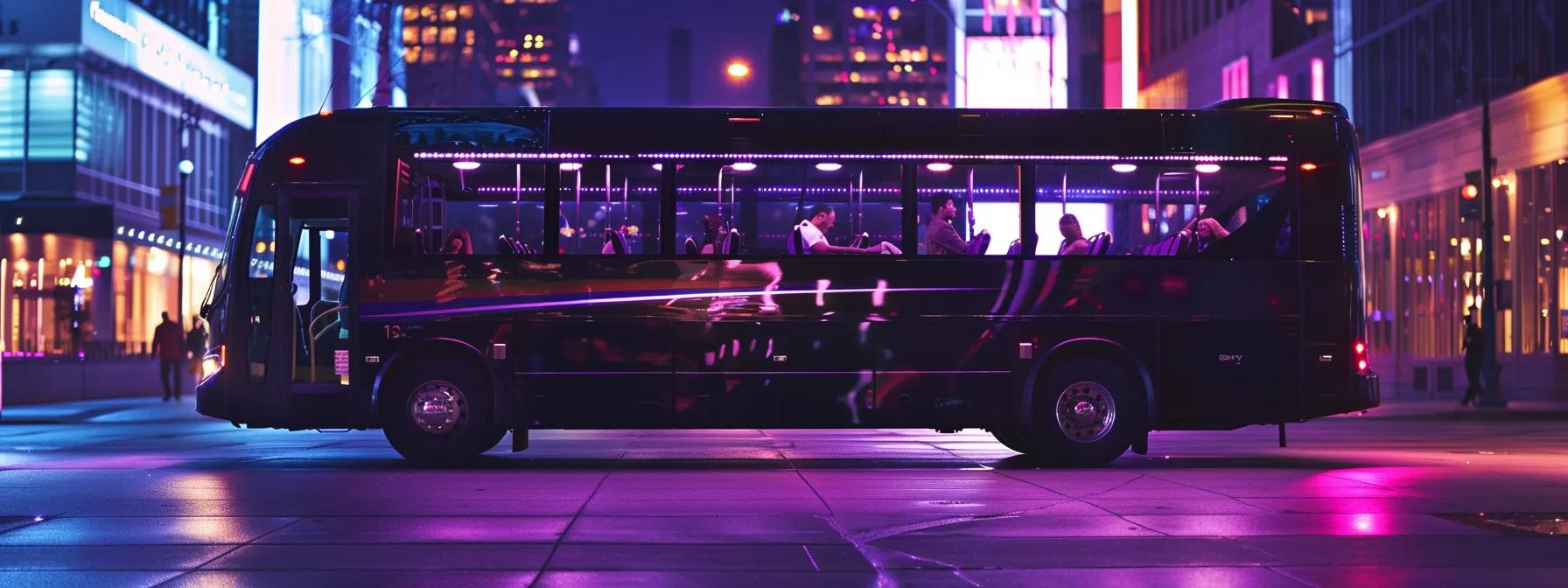The Impact of Party Bus Safety Regulations on Enjoyment

The Importance of Party Bus Safety Regulations
In the event transportation industry, ensuring passenger safety is paramount. Party bus safety regulations provide a roadmap for bus companies and drivers, reducing risks during events such as weddings, proms, and corporate functions. This article offers a comprehensive overview of the key regulations governing party bus safety, covering federal, state, and local rules; driver requirements and training; vehicle maintenance; and emergency, alcohol, and conduct policies. By meeting these standards—from designated driver rules to emergency exits and liability insurance—bus companies not only comply with laws but also build customer trust and protect against legal liabilities.
What Are the Key Party Bus Safety Regulations to Know?
Party bus safety regulations ensure that every aspect of transportation—from the motor vehicle’s construction to onboard procedures—meets strict safety guidelines. These rules help bus companies maintain proper vehicle condition, manage driver performance, and ultimately reduce risks to passengers.
Which Federal Regulations Govern Party Bus Safety?
Federal regulations, enforced by the Department of Transportation (DOT) and the Federal Motor Carrier Safety Administration (FMCSA), set standards for vehicle construction, maintenance, and operation. Federal rules require regular inspections, proper safety equipment such as seat belts, fire extinguishers, and clearly marked emergency exits. Additionally, federal laws regulate driver work hours and vehicle load capacities to prevent overworking drivers and overloading buses. These rules ensure a consistent standard that simplifies inspections and enforces safety protocols.
How Do State and Local Regulations Affect Party Bus Safety?
State and local regulations build on federal rules by addressing community-specific concerns. Local authorities inspect for compliance with parking, emissions, and noise ordinances. In some areas, additional permits or certifications may be required. Cooperation between law enforcement and transport inspectors ensures that safety violations are managed quickly. This layered regulatory system enhances safety by adapting to local traffic conditions and infrastructure needs.
What Role Does the Federal Motor Carrier Safety Administration (FMCSA) Play?
The FMCSA oversees commercial motor vehicles, including party buses, by enforcing operational rules that protect drivers, passengers, and the public. The agency conducts regular safety audits, compliance reviews, and driver qualification checks. Its mandatory reporting of accidents and safety violations helps address issues promptly. Programs like the Safety Fitness Determination monitor carriers and can suspend or revoke licenses if standards are unmet, ensuring accountability and reducing risks arising from negligence or poor maintenance.
Why Are Driver Requirements and Training Critical for Party Bus Safety?
Driver requirements and training are the backbone of party bus safety. Competent, well-trained drivers reduce risks on the road and instill confidence in passengers. Rigorous standards for driver licensing and training help minimize accidents and ensure that every passenger rides with a qualified chauffeur.

What Are the Commercial Driver’s License (CDL) Requirements for Party Bus Drivers?
Party bus drivers must hold a valid Commercial Driver’s License (CDL), obtained by passing comprehensive written and practical exams. These tests cover vehicle mechanics, defensive driving, and emergency protocols. Maintaining a clean driving record and passing health tests (such as vision and hearing) are also required. In addition, regular refresher courses keep drivers up to date with evolving safety standards and technological advances in bus design, ensuring ongoing competence.
How Does Driver Training Improve Passenger Safety?
Driver training emphasizes defensive driving, proper response to emergencies, and vehicle handling. Comprehensive programs prepare drivers for adverse weather, mechanical failures, or unexpected road situations. Regular situational drills and updates on new traffic laws help maintain driver alertness and readiness, reducing the risk of accidents and ensuring passengers feel secure.
What Are the Drug and Alcohol Testing Policies for Drivers?
Strict drug and alcohol testing policies ensure that drivers operate party buses while completely sober. Mandatory pre-employment, random, and post-accident tests (using breathalyzers and urine screenings) support a zero-tolerance policy toward impairment. This proactive approach prevents accidents caused by inebriation or substance abuse, upholding a high standard of safety.
How Does Vehicle Maintenance Ensure Party Bus Safety Compliance?
Regular and thorough vehicle maintenance is essential for safe party bus operation. Consistent upkeep ensures that all safety features work properly and that the vehicle complies with both federal and local regulations. Maintenance checks help prevent mechanical failures that could lead to accidents.
What Are the Pre-Trip and Post-Trip Inspection Procedures?
Drivers must perform systematic inspections before and after each trip. Pre-trip checks include verifying tire condition, brakes, lights, fluid levels, and ensuring that emergency equipment (fire extinguishers and first aid kits) is present and functional. Post-trip inspections help identify any issues encountered during the journey. Detailed logs and reports from these checks enable fleet operators to schedule necessary repairs, ensuring that the bus remains safe for continued operation.
Which Safety Features Must Be Maintained on Party Buses?
Critical safety features include functioning seat belts, clearly marked emergency exits, fire extinguishers, and first aid kits. Many modern party buses also feature video surveillance, GPS tracking, and real-time diagnostic systems. Additionally, systems such as automatic braking and stability controls are tested and calibrated regularly. Maintaining these features is vital for both accident prevention and reassuring passengers during their ride.
How Is Regular Vehicle Maintenance Monitored and Enforced?
Maintenance is overseen using internal protocols and external audits by regulatory bodies. Detailed maintenance logs record every service, inspection, and repair. Unannounced audits by government agencies and the use of advanced fleet management software help ensure that no crucial maintenance is overlooked. This oversight reduces the chances of mechanical failure and reinforces safety compliance at every level.
What Emergency Procedures Are Required on Party Buses?
Emergency procedures are critical in managing unexpected incidents on the road. Clear, well-practiced steps protect passengers, guide evacuation, and minimize injuries during emergencies.
How Are Emergency Exits and Safety Equipment Regulated?
Emergency exits and safety equipment must comply with federal and local codes. Regulations require multiple, accessible emergency exits that are unobstructed and clearly marked. Essential equipment such as fire extinguishers, first aid kits, and emergency hammers must be easily reachable. Routine drills and checks ensure that all emergency exits and safety systems remain fully operational, enabling quick evacuation when needed.
What First Aid and Fire Safety Measures Must Be in Place?
Party buses are required to carry comprehensive first aid supplies and fire safety equipment. First aid kits should include items like bandages, antiseptics, and emergency medications. In addition to fire extinguishers, buses must have smoke detectors, fire blankets, and clear exit procedures. Regular training for drivers and staff on how to use these tools ensures immediate and effective responses during emergencies.
How Should Passengers Respond During an Emergency?
Passengers should familiarize themselves with the bus layout as soon as they board, noting the location of emergency exits, fire extinguishers, and first aid kits. In an emergency, staying calm and following the driver’s instructions are crucial. Clear signage and audible alarms help guide a coordinated evacuation, reducing panic and ensuring a safe exit for everyone on board.
How Do Alcohol and Passenger Conduct Policies Impact Party Bus Safety?
Alcohol and passenger behavior policies are essential for maintaining a safe travel environment. These policies, which include monitored alcohol consumption and clear guidelines for passenger conduct, promote responsibility and reduce the risk of conflicts or accidents onboard.
What Are Safe Alcohol Consumption Guidelines on Party Buses?
Party buses balance celebration with safety by setting limits on alcohol service and assigning designated drivers or supervisors to monitor consumption. Companies may offer non-alcoholic alternatives and secure alcohol storage to prevent impulsive drinking. These guidelines help avoid excessive drunkenness, ensuring the driver remains alert and passengers behave safely.
How Are Passenger Responsibilities Enforced?
Passenger behavior is regulated through clear policies communicated during booking and again upon boarding. Onboard staff and monitoring systems help enforce these rules. Violations may result in fines or removal from the service, ensuring that all passengers contribute to a respectful and safe environment.
What Are the Consequences of Violating Alcohol and Conduct Policies?
Consequences for policy violations can include financial penalties, removal from the bus, or even legal action. Such strict enforcement discourages reckless behavior that could lead to accidents or injuries, emphasizing that every passenger is responsible for maintaining safety.
What Insurance and Liability Requirements Support Party Bus Safety?
Insurance and liability coverage are critical components of party bus safety, protecting both passengers and bus companies in the event of an accident. Comprehensive coverage helps manage compensation claims and supports a secure operating environment.

What Insurance Coverage Is Required for Party Bus Operators?
Operators must maintain comprehensive insurance that covers general liability, collision, and other risks. This coverage protects against property damage and bodily injury claims. Insurance policies extend to the vehicle and its passengers, with operators required to meet minimum coverage thresholds set by state regulations. Such robust insurance reassures customers and underscores the company’s commitment to safety.
How Does Insurance Protect Passengers and Operators?
Insurance ensures that, should an accident occur, financial resources are available for medical treatment, legal claims, and repairs. For operators, it minimizes the impact of potential financial losses, ensuring business continuity. Stringent insurance requirements also encourage companies to adhere strictly to safety standards to avoid claim penalties or increased premiums.
How Can Passengers Ensure Their Safety When Using Party Bus Services?
Passengers play an active role in their own safety by verifying that the party bus service adheres to high safety standards. Being informed about safety features, maintenance practices, and company policies can help passengers make better transportation choices.
What Safety Features Should Passengers Look For?
Key safety features include clearly marked emergency exits, functioning seat belts, up-to-date fire extinguishers, and accessible first aid kits. Modern buses often have additional safety technology such as GPS tracking and onboard cameras. A brief safety demonstration at the start of the ride can further reassure passengers that all safety protocols are in place.
How Can Passengers Verify a Party Bus Company’s Compliance?
Passengers can check for visible certifications, review posted maintenance logs, and even read online reviews. Requesting details about driver training and recent safety inspections from company representatives further confirms that the operator meets high safety standards.
What Are Best Practices for Passenger Safety During the Ride?
Passengers should always remain seated with seat belts fastened, follow driver instructions, and avoid disruptive behavior. Familiarizing oneself with emergency exits and safety equipment, as well as moderating alcohol consumption, helps maintain a secure and pleasant riding experience.
Comprehensive List of Passenger Safety Verification Steps
To help passengers choose a safe party bus service, consider this checklist:
Check Certifications and Insurance – Ensure the company displays up-to-date certifications and has comprehensive insurance coverage.
Review Maintenance Logs – Ask to review records verifying that pre-trip and post-trip inspections are performed regularly.
Inspect Safety Equipment – Confirm the presence of clearly marked emergency exits, functional seat belts, fire extinguishers, and first aid kits.
Evaluate Driver Credentials – Verify that drivers hold valid commercial licenses and have undergone required drug and alcohol testing.
Read Customer Reviews – Look for online testimonials regarding the company’s adherence to safety protocols.
Ask About Emergency Procedures – Inquire if the company provides clear instructions and demonstrations of evacuation routes and first aid methods.
Assess Onboard Technology – Check for GPS tracking, video surveillance, and diagnostic systems that monitor vehicle performance.
Each step enables passengers to verify that their chosen party bus service upholds high safety standards.
Frequently Asked Questions
Q: What are the key federal regulations that affect party bus operations? A: Federal regulations set by the DOT and FMCSA mandate vehicle inspections, driver qualifications, and operational protocols, ensuring all buses meet strict maintenance and safety equipment standards.
Q: How often should party bus vehicles be inspected for safety? A: Vehicles are inspected before and after each trip, with additional regularly scheduled maintenance checks per federal and state guidelines to detect potential hazards early.
Q: What qualifications do party bus drivers need to operate safely? A: Drivers must hold a valid CDL, pass rigorous written and practical exams, and regularly undergo drug/alcohol testing and refresher training to remain current on safety practices.
Q: How does proper insurance coverage on party buses protect passengers? A: Comprehensive insurance—including liability and collision coverage—ensures that any injuries or property damage are financially covered, reinforcing the operator’s commitment to high safety standards.
Q: What emergency procedures should passengers familiarize themselves with on a party bus? A: Passengers should know the locations of emergency exits, fire extinguishers, and first aid kits and understand the evacuation procedure as demonstrated at the start of the ride.
Q: What steps can passengers take to verify a party bus company's compliance with safety regulations? A: Passengers can review certifications, maintenance logs, and customer reviews, and directly inquire about driver training and safety inspection records.
Q: How do alcohol and conduct policies impact overall party bus safety? A: Strict policies help maintain order by limiting alcohol consumption and ensuring passengers behave responsibly, reducing the risk of accidents and injuries.
Final Thoughts
Party bus safety regulations are essential to ensuring every ride is secure, compliant, and enjoyable. By integrating federal, state, and local standards with strict driver training, regular vehicle maintenance, and robust emergency procedures, operators create a high-standard safety environment. Passengers who verify these measures through detailed checklists can confidently book services that prioritize their safety. Ultimately, a strong commitment to safety not only enhances the transportation experience but also builds trust and drives future bookings.
